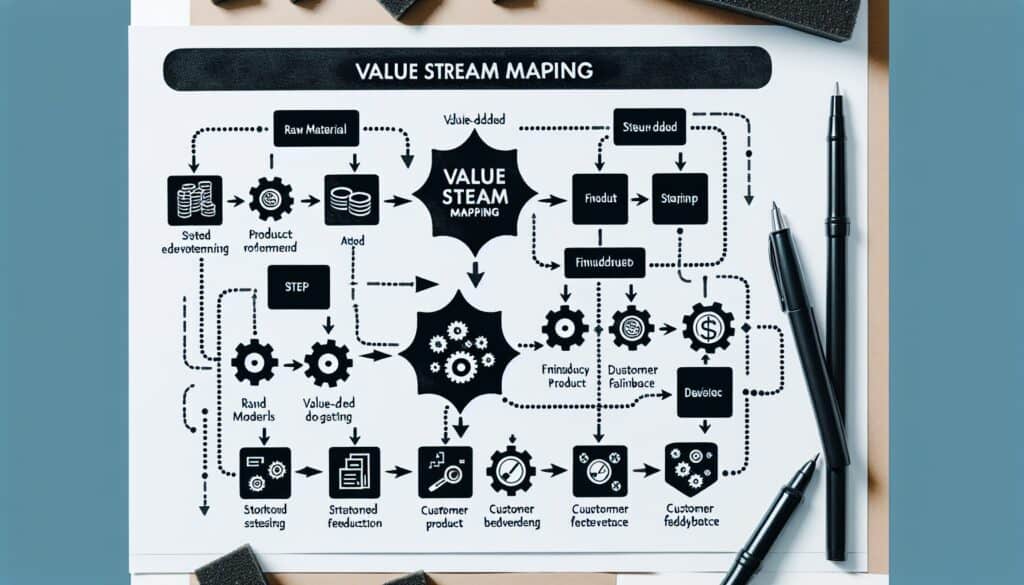一种精益管理工具,用于可视化、分析和改进产品或服务交付流程中从原材料到客户的所有步骤(包括增值和非增值)。
- 方法: 客户与营销, 构思, 产品设计
价值流图(VSM)

价值流图(VSM)
- 持续改进, 精益制造, 精益生产, 流程改进, 流程制图, 价值分析, 价值评估工程(VE), 价值流映射, 消除废物策略
目标
如何使用
- 包括绘制 "现状图",显示材料和信息的流动情况,找出浪费和瓶颈。然后,设计 "未来状态图",提出减少浪费和改善流程的改进措施,并制定实施计划。
优点
- 提供整个流程的整体视图;帮助识别和消除浪费 (泥田可促进系统层面的思考,而不是孤立的流程优化;可视化工具,加强沟通。
缺点
- 创建过程可能很复杂、耗时,尤其是对于大型价值流而言;需要跨职能团队的积极参与;未来状态的实现需要大量的努力和变革管理。
类别
- 精益西格玛, 制造业, 解决问题, 项目管理, 质量
最适合:
- 识别并消除流程中的浪费,以改善流程、缩短交付周期并提高交付给客户的价值。
在制造业、医疗保健和软件开发等各行各业中,价值流图(VSM)都是一种强大的方法,在这些行业中,了解价值流至关重要。例如,在制造业,汽车公司利用 VSM 对车间流程进行可视化,使他们能够找出装配线和材料处理系统之间的低效环节。在医疗保健领域,医院利用 VSM 来优化病人流程,从而在最大限度缩短等候时间的同时提高服务质量。这种方法在项目的初始阶段尤为有效,因为绘制当前的运营图可以带来显著的改进。参与者通常包括由工程师、操作员和利益相关者组成的跨职能团队,他们对流程挑战和机遇提出了不同的观点。定期举办研讨会或 改善 随着流程的发展,活动可以为这一做法注入活力,鼓励对当前和未来状态图进行持续更新。VSM 的一大特点是可视化,这不仅简化了复杂的工作流程,还促进了团队成员之间的沟通,促进了对目标和指标的共同理解,从而推动绩效的提高。将 VSM 的发现导出为行动计划,为变革设定了结构化的路径,从而显著缩短周期时间,提高客户满意度。协作式方法强化了持续改进的文化,支持企业追求以下目标 精益原则 同时建立一个可持续的卓越运营框架。
该方法的关键步骤
- 绘制说明材料和信息流的现状图。
- 确定当前状态图中的浪费领域和瓶颈。
- 分析已确定的废物,并根据其影响确定优先次序。
- 设计一张未来状态图,以改善流程为特色。
- 制定实施计划,详细说明实现未来状态的行动。
- 建立衡量标准,以衡量实施后的改进情况。
- 向利益相关方传达未来状态和实施计划。
- 执行实施计划并定期监测进展情况。
专业提示
- 将反馈回路纳入 VSM 流程,以实现持续改进和实时调整。
- 在定性观察的同时,利用数据驱动的衡量标准,为现状分析提供信息,从而绘制出更可靠的地图。
- 在两个绘图阶段都让跨职能团队参与进来,以确保不同的视角并加强合作解决问题。
历史背景
1949
1950
1950
1960
1960
1960
1960
1940
1950
1950
1958
1960
1960
1960
1960
(如果日期不详或不相关,例如 "流体力学",则对其显著出现的时间作了四舍五入的估计)。















相关文章
制造运营管理(MOM)
制造执行系统(MES)
生产控制计划
人工测试
手动搬运评估表 (MAC)
手动任务风险评估工具(ManTRA)